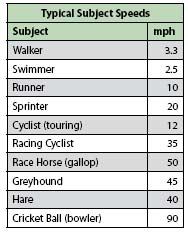articles/Sports/sportingchance-page3
Sporting Chance - part 3 of 1 2 3 4 5 6 7
by Mike McNamee Published 01/09/2006

These calculations assume that stopping action is vital. In reality this is not so. Aesthetics demands a bit of blur to create a sense of movement. The trick is to make it look like you meant it, not that you were incompetent! Note two other things. An image stabilising lens is of no help in stopping subject movement, all it will do is prevent you from adding camera shake to an already slightly fuzzy subject. The calculations assume that the subject is moving across the field of view.
If the action is coming diagonally towards you, you can grab about a half stop to your benefit; if the action is directly towards you, you can grab just over a stop.
This assumes that the subject is moving at a single speed. However, a bowler running up to deliver is going at 20mph and if you are panning at that speed he is stationary on the film. However his arm is moving at 70mph at the ball but is effectively at zero mph at the shoulder. The ground is moving at an effective -20mph (backwards across the frame) which is why it is possible to have a near sharp bowler and a nice blur on the crowd in the background.
The speed differential is even greater if you are panning a racing car. Here the axle of the wheel has zero translational speed, the bottom of the wheel is stationary (if you are panning exactly) but the top of the wheel is moving forward at twice the speed of the vehicle. While all this is going on the rotational speed of the wheel is whatever it is. The net effect is almost sharp writing on Jensen Button's helmet, a blurred background and rotationally blurred wheels.
If, in addition, the car is pitching under braking or due to a bumpy surface then only the logos in the centre of that pitching motion will be sharp. This is an effect you can sometimes see on motorbikes as they dig their noses in under heavy braking into a bend.
There is one piece of advice that jumps out from this analysis. The subject movement is complex so be careful when analysing your output and seeking improvements. At first glance the cricket shot on the opening spread looks suspect.
However a more careful look shows that the feet are pin sharp (you can see the individual stitches) but the shot gets progressively more blurred as the rotational movement increases up the batsman's body. Hackett's slash at the ball did not trouble the leather but sure did scare the life out of it! (Sigma 500mm f4.5; 1/800ths at full aperture. 400ISO Nikon D200)
The next demon for the photographer to lay to rest is depth of field. This is very small on telephoto lenses, especially at the wide apertures needed to get fast shutter speeds. As we have already seen, apertures of around f2.8 are needed to get optimum shutter speeds.
Harking back to our hockey example, we see that the depth of field for a 300mm lens at f2.8 and a working distance of 20m is a little over half a metre. That is around the length of an outstretched leg and unless you get your focus on the knee of the player, the torso and foot stand little chance of being sharp. These compromises are ones that most sports photographers have to accept.
Please Note:
There is more than one page for this Article.
You are currently on page 3
- Sporting Chance page 1
- Sporting Chance page 2
- Sporting Chance page 3
- Sporting Chance page 4
- Sporting Chance page 5
- Sporting Chance page 6
- Sporting Chance page 7
1st Published 01/09/2006
last update 18/07/2022 16:35:44
More Sports Articles
There are 19 days to get ready for The Society of Photographers Convention and Trade Show at The Novotel London West, Hammersmith ...
which starts on Wednesday 14th January 2026








